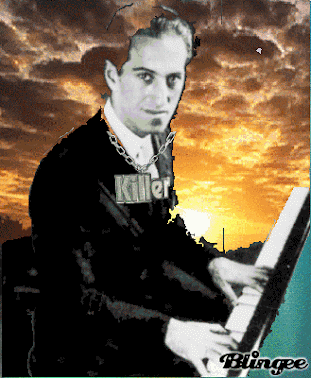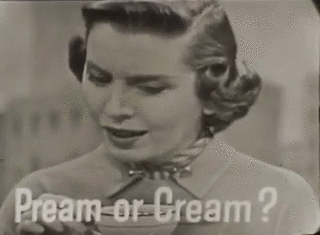Sunday, June 6, 2021
⭐SUPER-BLOOPER: Bogart and Bette Davis ⭐
Saturday, June 5, 2021
Oh me, oh my: LOVE Aunt Jenny's Pie! (and it's made with SPRY!)
Wednesday, June 2, 2021
Tuesday, June 1, 2021
A Serious George Gershwin Problem, Volume Two
Link to Original Slideshow by Astairical
POST-IT NOTES: I found this rhapsodic (in blue) tribute a few years ago, God knows where, and took a liking to it immediately. I had been trying to chop my way through a 900-page tome on Gershwin's life (90% of it was a minute and detailed dissection of the show tunes he wrote before he became really famous; only one chapter 50 pages long was devoted to "Gershwin the Man".) When I found this, I thought - hey, why not? This fan tribute really gives us the essence of who and what Gershwin was. It's also plain this girl was CRAZY ABOUT THE MAN - mad about the boy - and expressed it in contemporary language that I actually find quite charming. I blew it up here to make the text more readable. I don't know what happened to Astairical after this - haven't been able to find anything on her (at least I THINK it's a her), but this stands as one of the most unusual Gershwin tributes - hell, one of the best tributes ANYWHERE about ANYONE or ANYTHING, period!
As with Dylan, I'm drawn back to Gershwin cyclically, pulled back into his orbit again and again. There were similarities: Gershwin broke all the rules, all the while beguiling his public with a magnetism that is hard to describe. But unlike Dylan, who is still doing amazingly well at age 80, he died horribly of an undiagnosed and agonizing brain tumor at only 38. Because his death on the operating table was so shocking and unexpected, it's possible he did not know he was dead, which can cause a great deal of spiritual disorientation. It's said that his ghost roams freely, and even his brother Ira, who did NOT believe in such things, saw him waving at him from his study shortly after he passed. Ira did not tell anyone about this until he was on his deathbed, afraid people would think he was crazy. But others saw him too: sitting mischievously at a player piano in a town square, hurrying along the street with his head down, his face just visible in a crowd - no, wait a minute, it COULDN'T be.
I myself felt a visitation. I can't prove or disprove this, but it was a gift, so I don't throw it away. Paul Biscop, a former friend and spiritualist medium, had a way of disparaging MY experiences (though his were always bona fide - he had two Masters degrees and a PhD, so anything he said about spiritualism automatically trumped mine, and he often wrote off the experiences I shared with him as "fantasies").
I won't write a lot about how he died, but I had my mojo working on him not long before that: I made a formal request, or spell, or whatever you want to call it, not that he'd die or anything, or even suffer, but that he'd SEE, for once and for all, just how destructive his dismissive behaviour could be, how hurtful to others his pose as a "nice" person who had a very dark heart. I will admit this involved beads, candles, incense, chanting, and even a little Haitian voodoo. Some of it I had learned in a course I took from Paul called The Anthropology of Religion.
Paul had dissed my Gershwin connection, the powerful sense I'd somehow - I can't explain it - "felt" him steal into the room, wordlessly, longing to connect with someone who would believe in him and deeply listen. I wrote about this in a blog post I've re-posted several times called Gershwin's Ghost.
So what's the message here? Nothing, except that dear George still inspires strong feelings, and he DOES hang around because of the unfairness and confusion of his early death, his head cracked open by ignorant surgeons only to find a grapefruit-sized tumor that had been there for years, causing him agonizing pain and ruining his co-ordination so he couldn't even play the piano any more. Right up until his death, his deterioration had been considered a manifestation of "neurosis". He deserved so much more than that. Incredibly, he wrote the exquisite song But Not for Me very shortly before he died - kind of ironic, considering the circumstances:
"They're writing songs of love, but not for me
A lucky star's above, but not for me
With love to lead the way, I've found more clouds of grey
Than any Russian play could guarantee. . ."
Monday, May 31, 2021
FOLK ROT: Something is happening, but you don't know what it is
In September 1965, singer Ewan MacColl scourged Dylan again in Sing Out!:
“. . . our traditional songs and ballads are the creations of extraordinarily talented artists, working inside disciplines formulated over time. . . the present crop of contemporary American songs has been made by writers who are either unaware or incapable of working inside the disciplines, or are at pains to destroy them. ‘But what of Bobby Dylan?’ scream the outraged teenagers of all ages. . . a youth of mediocre talent. Only a completely non-critical audience, nourished on the watery pap of pop music, could have fallen for such tenth-rate drivel. ‘But the poetry?’ What poetry? The cultivated illiteracy of his topical songs or the embarrassing fourth-grade schoolboy attempts at free verse? The latter reminds me of elderly female schoolteachers clad in Greek tunics rolling hoops across lawns at weekend theatre school. . .”
Izzy Young’s Sing Out! column for November 1965: “Dylan has settled for a liaison with the music trade’s Top-Forty Hit Parade. . . the charts require him to write rock-and-roll and he does. . . Next year, he’ll be writing rhythm and blues songs. . . the Polish polka will make it, and then he’ll write them, too. . .”
Animosity reached its high-water mark in the Sing Out! of January 1966. Tom Paxton lashed out in a column headed “Folk Rot” “. . . it isn’t folk, and if Dylan hadn’t led, fed and bred it, no one would ever have dreamed of confusing it with folk music.” Josh Dunson complained: “There is more protest and guts in one minute of good ‘race music’ than in two hours of folk-rock. . .”
You've got a lotta nerve to say you are my friend
When I was down you just stood there grinnin'
You've got a lotta nerve to say you got a helping hand to lend
You just want to be on the side that's winnin'
You say I let you down, you know it’s not like that
If you're so hurt, why then don't you show it?
You say you've lost your faith, but that's not where it’s at
You have no faith to lose, and you know it
I know the reason that you talked behind my back
I used to be among the crowd you're in with
Do you take me for such a fool, to think I'd make contact
With the one who tries to hide what he don't know to begin with?
You see me on the street, you always act surprised
You say "how are you?", "good luck", but you don't mean it
When you know as well as me, you'd rather see me paralyzed
Why don't you just come out once and scream it
No, I do not feel that good when I see the heartbreaks you embrace
If I was a master thief perhaps I'd rob them
And now I know you're dissatisfied with your position and your place
Don't you understand, it’s not my problem?
I wish that for just one time you could stand inside my shoes
And just for that one moment I could be you
Yes, I wish that for just one time you could stand inside my shoes
You'd know what a drag it is to see you
Sunday, May 30, 2021
Saturday, May 29, 2021
"Do You See Colour on Your TV?"
Topics: How to make a Black and White television show color
Something happened that reminded me of this tonight, and I think I have finally made sense of something seen as a kid. For some odd reason it just hit me. When I was fairly young and living in the Los Angeles area, there was a test done one night on a local TV channel that was supposed to produce a color picture on the black and white TVs commonly in use. And I can recall seeing some color; I think mostly green.
From time to time I have thought about this and wondered what it was that I saw. In fact at times I have doubted the memory as it didn't make any sense, but I can remember the event very clearly. Tonight it occurred to me what they were probably up to. I bet that they were strobing the white to produce a false color image, as is done with alternating black and white dots on a rotating wheel [I don't recall the name of the effect].
The idea is that each pixel on the screen would be strobed at the frequency required to produce the desired color for that dot. Does this make sense? I'm not sure what the strobe rate is that produces the false color effect, or if this was doable on B&W televisions, but it is the only thing that has even threatened to make any sense here. Is there any other way that one can imagine producing color on a B&W screen?
When I was a kid we lived the Los Angeles area. We had a (POS) Packard Bell black & white TV in the family room (color TVs were new technology and my parents were skeptical).
One day a Sprite commercial came on and the voiceover said something to the effect of "Sprite is so bursting with flavor that you're probably seeing color on your B&W TV!". I remember scrambling over to the TV, and sure enough, there was a static image of a Sprite bottle, and it was kind of in color.
This is apparently an approximation of what some viewers saw, although I only remember seeing a pale green and possibly red.
One of the earliest test broadcasts of this technology was in 1967 or 1968 on KNXT Channel 2 in Los Angeles.
The Squirt Soft Drink Subjective Color Acid Test
On July 25, 1967, television viewers with black-and-white TV sets were startled to see flashes of color on their monochrome screens for about ten seconds during a 60-second soda-pop commercial. A letter to a columnist in the September 14, 1967 Detroit Free Press asked, "Before I see an eye doctor, let me ask Action Line: Is it possible to pick up color TV on a black and white set? I SWEAR I saw a Squirt soft-drink commercial in color. Not pink elephants Green Squirt!" The image was described in the newspaper column as a red, green and blue sign that had flashed on the screen.
A viewer in Chicago told Popular Photography magazine (July 1968), "I saw pink! It knocked me for a loop...the letters S-Q-U-I-R-T looked greenish or light turquoise...and it kept up for maybe 10 seconds." (Meanwhile a viewer in San Francisco claimed he didn't see anything colorful.)
It was the national debut of an experimental television commercial using a special production process that would give the optical illusion of color. The commercial first aired a few months earlier locally on KNXT, the CBS-owned television station in Los Angeles, and viewers there were just as stunned. Squirt and its advertising partner Color-Tel Corporation of Los Angeles, at the time decided to make no prior announcement of this experimental commercial, preferring to see just how viewers would respond. And respond they did. Within hours, thousands of viewers were asking if they really saw what they thought they did, color on their black-and-white TV screens, according to Popular Electronics magazine (October 1968).
ADDENDA! I found more stuff on this weird subject, to my surprise, but it was such a long piece that I only include a few excerpts here. And it does explain why so few people remember this arcane experiment, or if they do, question the veracity of those memories. The color-on-a-black-and-white-TV experiment was extremely brief, due to the fact that it FLOPPED. Had it come along ten years earlier, maybe. Like Segway, which was supposed to revolutionize transportation as we knew it - it didn't. It didn't revolutionize ANYTHING, and just made a few people (such as myself) doubt their own memories or even feel crazy for having them.
But there was one giant flaw in that rosy prediction. By 1968, black-and-white TV was well on the way out. The vast majority of programming (outside of old movies and TV shows) were being broadcast in "living" color by then, and while most U.S. households still had black-and-white TV sets (color sets were big, bulky and expensive in those days), more and more homes were purchasing color television sets every year. Had James F. Butterfield perfected the process ten or fifteen years earlier, in the 1950s when 90 percent of television broadcasts were black and white, it might have had more of a serious impact.



















































